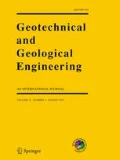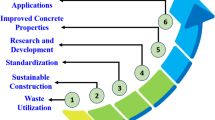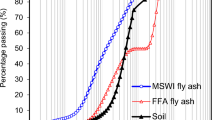Abstract
The improvement of salt affected lands is a major environmental challenge in arid and semi arid regions all over the world. Electrokinetic treatment is one of the environmentally friendly and cost-effective methods that can be used in reclamation of saline soils. In this study, the effect of electrokinetic remediation (EKR) on compressibility characteristics of fine-grained salt affected soils was investigated. The soil samples were subjected to the following applied voltage gradients of 1, 2 and 3 V/cm during 7 days, followed by oedometer tests to evaluate the soil consolidation parameters. The obtained results are presented and discussed regarding to the variation of applied potential on compressibility characteristics of the treated soil samples. Experimental results show that each of compressive index and swelling index decreases with increasing the voltage, whereas preconsolidation pressure increase. These variations were attributed to water flow between electrodes and migrations of salt cations toward the cathode. Moreover, EKR demonstrates changes in soil pH as a result of electrolyse soil reactions. This research reveals that the use of EKR using direct current improves compressibility characteristics of saline soils involving a short time period. This process proves that it can be successful to soil remediation for civil engineering use.


Source: World Meteorological Organization (WMO). United Nations Environment Programme (UNEP)






Similar content being viewed by others
Data Availability
The datasets generated during and/or analysed during the current study are not publicly because individual privacy could be compromised, but are available from the corresponding author on reasonable request.
References
Acar YB, Alshawabkeh AN (1993) Principles of electrokinetic remediation. Environ Sci Technol 27(13):2638–2647
ASTM D2435 (2011) Standard Test Methods for One-Dimensional Consolidation Properties of Soils Using Incremental Loading. Annual Book of ASTM Standards, Section 4, Vol. 04.01, Soil and Rock Building Stones. ASTM International, West Conshohocken
Aydemir S, Sünger H (2011) Bioreclamation effect and growth of a leguminous forage plant (Lotus corniculatus) in calcareous saline sodic soil. Afr J Biotechnol 10:115571–115577
Azhar ATS, Azim MAM, Aziman M, Nabila ATA (2016) Leachability of arsenic contaminated landfill soil stabilised by cement and bagasse ash. IOP Conference Series Mater Sci Eng 160:1–9
Azhar ATS, Azim MAM, Syakeera NN, Jefferson IF, Rogers CDF (2017) Application of electrokinetic stabilisation (EKS) method for soft soil: IOP conference series. Mater Sci Eng 226:012075. https://doi.org/10.1088/1757-899X/226/1/012075
Barker JE, Rogers CDF, Bordman DI, Peterson J (2004) Electrokinetic stabilisation: an overview and case study. Ground Improv 8(2):47–58
Bessaim MM, Missoum H, Bendani K, Laredj N (2019) Laboratory investigation on solutes removal from artificial amended saline soil during the electrochemical treatment. Int J Environ Sci Technol 16(7):3061–3070. https://doi.org/10.1007/s13762-018-1914-5
Bessaim MM, Missoum H, Bendani K, Laredj N, Bekkouche MS (2020a) Effect of processing time on removal of harmful emerging salt pollutants from saline-sodic soil during electrochemical remediation. Chemosphere 253:126688. https://doi.org/10.1016/j.chemosphere.2020.126688
Bessaim MM, Missoum H, Bendani K, Laredj N, Bekkouche MS (2020b) Sodic-saline soil remediation by electrochemical treatment under uncontrolled pH conditions. J Geosci 13(5):1–13
Butcher K, Wick AF, Desutter T, Harmon J (2016) Soil salinity: a threat to global food security. Agron J 108(6):2189–2200. https://doi.org/10.2134/agronj2016.06.0368
Cameselle C (2015) Enhancement of electro-osmotic flow during the electrokinetic treatment of a contaminated soil. Electrochim Acta 181:31–38
Cameselle C, Gouveia S (2018) Phytoremediation of mixed contaminated soil enhanced with electric current. J Hazard Mater 361:95–102. https://doi.org/10.1016/j.jhazmat.2018.08.062
Casagrande A (1936) The determination of pre-consolidation load and it’s practical significance. Int Conf Soil Mech Geotech Eng 3:60
Faisal AAH, Sulaymon AH, Khaliefa QM (2018) A review of permeable reactive barrier as passive sustainable technology for groundwater remediation. Int J Environ Sci Technol 15:1123–1138
FAO (Food and Agriculture Organization) (2011) The state of the world’s land and water resources for food and agriculture Managing systems at risk. The Food and Agriculture Organization of the United Nations and Earthscan, London
FAO (2015) Food and agriculture organization of the United Nations. Italy, Rome
Fattah MY, Al-Haddad SA, Al-Khafaji KR (2020) Compressibility characteristics of soft clays treated by graphene. IOP Conference Series Mater Sci Eng 978(1):012035
Han K, Han S, Kim E, Cho H, Seo Y, Lee H, Junghun O, Seo M, Jung K, Zhang Y (2017) Salt removal of greenhouse soils using electrokinetic technology. Appl Biol Chem 60(5):477–485
Han D, Wu X, Li R, Tang X, Xiao S, Scholz M (2021) Critical Review of Electro-kinetic Remediation of Contaminated Soils and Sediments: Mechanisms, Performances and Technologies. Water Air Soil Pollut 232(8):1–29
Ivushkin K, Bartholomeus H, Bregt AK, Pulatov A, Kempen B, Sousa LD (2019) Global mapping of soil salinity change. Sens Environ. https://doi.org/10.1016/j.rse.2019.111260
Jayasekera S (2015) Electrokinetics to modify strength characteristics of soft clayey soils: a laboratory based investigation. Electrochim Acta 181:39–47
Jayasekera S, Hall S (2006) Modification of the properties of salt affected soils using electrochemical treatments. Geotech Geol Eng 25:1–10
Jo S, Shin YJ, Yang JS, Moon DH, Koutsospyros A, Baek K (2015) Enhanced electrokinetic transport of sulfate in saline soil. Water Air Soil Pollut 226(6):199
Joâo MJ, Danko AS, Fiúza A, Borges MT (2015) Phytoremediation of salt-affected soils: a review of processes, applicability, and the impact of climate change. Environ Sci Pollut Res Int 22(9):6511–6525. https://doi.org/10.1007/s11356-015-4205-4
Lee S, Yun JM, Lee JY, Hong G, Kim JS, Kim D, Han JG (2021) The remediation characteristics of heavy metals (copper and lead) on applying recycled foodwaste ash and electrokinetic remediation techniques. Appl Sci 11:7437. https://doi.org/10.3390/app11167437
Lefebvre G, Burnotte F (2002) Improvements of electroosmotic consolidation of soft clays by minimizing power loss at electrodes. Can Geotech J 39(2):399–408. https://doi.org/10.1139/t01-102
Li H, Muhammad F, Yan Y, Zhang M, Jiao B, Yu L, Li D (2018) Electrokinetic remediation of heavy metals from municipal solid waste incineration fly ash pretreated by nitric acid. R Soc Open Sci 5(8):180372
Mendez E, García JA, Hernndez G, Solís S, Prieto F, Pamukcu S, Bustos E (2019) Study of electrochemical removal of phenanthrene in bentonite clay by physicochemical indicators. Sep Purif Technol 208:92–99
Mitchell JK (1993) Fundamentals of Soil Behavior. Wiley, New York
Ondrasek G, Rengel Z, Veres S (2011) Soil salinisation and salt stress in crop production. Abiotic Stress Plants-Mechanisms Adaptation. https://doi.org/10.5772/22248
Ou CY, Chien SC, Wang YG (2009) On the enhancement of electroosmotic soil improvement by the injection of saline solutions. Appl Clay Sci 44:130–136
Qadir M, Oster J (2002) Vegetative bioremediation of calcareous sodic soils: history, mechanisms, and evaluation. Irrig Sci 21:91–101. https://doi.org/10.1007/s00271-001-0055-6
Qadir M, Oster JD (2004) Crop and irrigation management strategies for saline-sodic soils and waters aimed at environmentally sustainable agriculture. Sci Total Environ 323:1–19
Qadir M, Ghafoor A, Murtaza G (2000) Amelioration strategies for saline soils: a review. Land Degrad Dev 11:501–521. https://doi.org/10.1002/1099-145X(200011/12)11:63.0.CO;2-S
Rogers CDF, Liaki C and Boardman DI (2003) Advances in the engineering of lime stabilised clay soils. Proc Int Conf Problem Soils. Nottingham.
Sadeghian F, Jahandari S, Haddad A, Rasekh H, Li J (2022) Effects of variations of voltage and pH value on the shear strength of soil and durability of different electrodes and piles during electrokinetic phenomenon. J Rock Mech Geotech Eng 14(2):625–635. https://doi.org/10.1016/j.jrmge.2021.07.017
Sahab S, Suhani I, Srivastava V, Chauhan PS, Singh RP, Prasad V (2021) Potential risk assessment of soil salinity to agroecosystem sustainability: current status and management strategies. Sci Total Environ 764:144164. https://doi.org/10.1016/j.scitotenv.2020.144164
Wang Y, Li A, Cui H (2021) Remediation of heavy metal contaminated soils by electrokinetic technology: mechanisms and applicability. Chemosphere 265:129071
Wild A (2003) Soils, land and food: managing the land during the twenty-first century. Cambridge University Press
Wong VNL, Dalal RC, Greene RSB (2009) Carbon dynamics of sodic and saline soils following gypsum and organic material additions: a laboratory incubation. Appl Soil Ecol 41:29–40
Xue S, Zhu F, Kong X, Wu C, Huang L, Huang N, Hartley W (2016) A review of the characterization and revegetation of bauxite residues. Environ Sci Pollut 23(2):1120–1132
Zaman M, Shahid S, Heng LK (2018) Guideline for salinity assessment, mitigation and adaptation using nuclear and related techniques. Springer, Cham
Zhang Y, Chu G, Dong P, Xiao J, Meng Q, Baumgartel M, Xu B, Hao T (2018) Enhanced electrokinetic remediation of lead-and cadmium-contaminated paddy soil by composite electrolyte of sodium chloride and citric acid. J Soils Sediments 18(5):1915–1924
Zhu S, Zhang J, Dong T (2009) Removal of fluorine from contaminated field soil by anolyte enhanced electrokinetic remediation. Environ Earth Sci 59:379–384
Ziaie MR, Haratian M, Izadi E (2011) Improvement of volume change characteristics of saline clayey soils. J Appl Sci 11:76–85
Acknowledgements
The authors are grateful for the financial support received from the Directorate General for Scientific Research and Technological Development, Algeria.
Funding
This work was supported by the Directorate General for Scientific Research and Technological Development, Algeria.
Author information
Authors and Affiliations
Contributions
All authors contributed to the study conception, Material preparation, data collection and analysis. All authors read and approved the final manuscript.
Corresponding author
Ethics declarations
Conflict of interest
The authors have no relevant financial or non-financial interests to disclose.
Additional information
Publisher's Note
Springer Nature remains neutral with regard to jurisdictional claims in published maps and institutional affiliations.
Rights and permissions
About this article
Cite this article
Hadjadj, F.Z., Laredj, N., Maliki, M. et al. Influence of Electrokinetic Process on Compressibility Behaviour of Salt Affected Soils. Geotech Geol Eng 40, 4159–4170 (2022). https://doi.org/10.1007/s10706-022-02147-0
Received:
Accepted:
Published:
Issue Date:
DOI: https://doi.org/10.1007/s10706-022-02147-0





